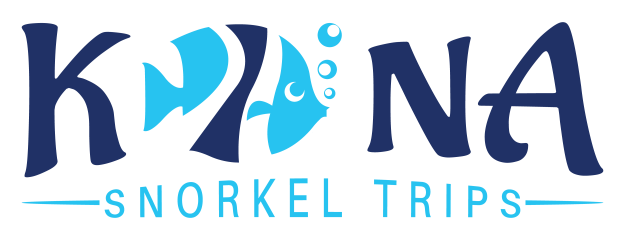Unforgettable Whale Watching Tours Kona Hawaii – Book Today!
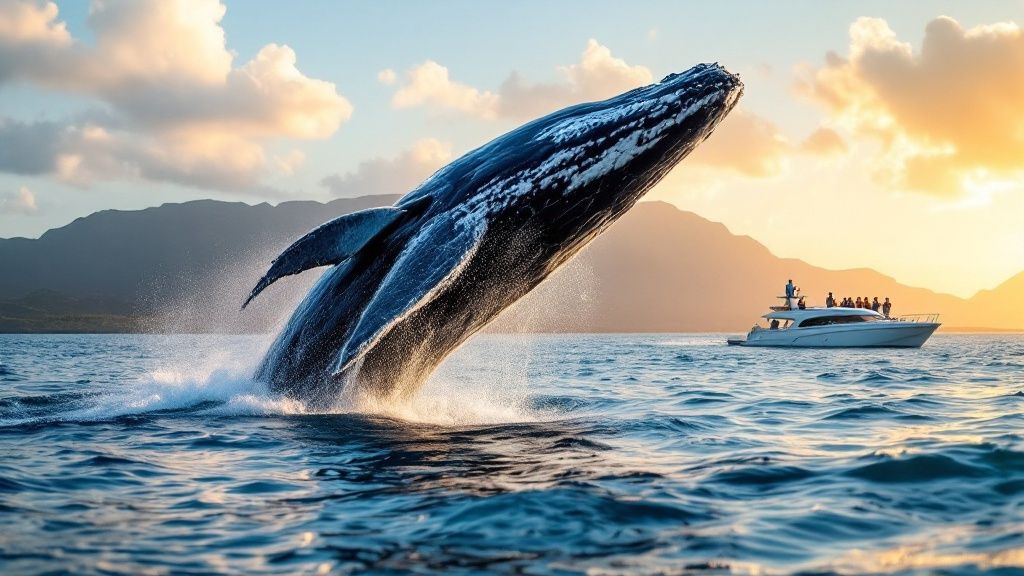
Welcome to the pristine waters of Kona, the Big Island's undisputed champion for watching the awe-inspiring migration of humpback whales. The absolute best whale watching tours Kona Hawaii has to offer run from December through May, with January and February being the sweet spot for peak activity. Think of this as your complete playbook for planning an unforgettable day on the water.
As Hawaii's top rated & most reviewed snorkel company in Hawaii, Kona Snorkel Trips sets the bar for marine adventures.
Your Guide to Kona's Humpback Whale Encounters
Picture this: the deep blue of the Pacific suddenly shatters as a 40-ton humpback whale explodes from the surface, hanging in the air for a breathtaking moment. This isn't a rare sight along the Kona coast—it's the main event. Our coastline serves as a vital nursery and sanctuary for these gentle giants.
Every year, thousands of humpbacks make an epic 3,000-mile journey from their feeding grounds in Alaska. They seek out Kona's warm, sheltered waters to mate, give birth, and nurse their newborn calves, making for some truly spectacular encounters.
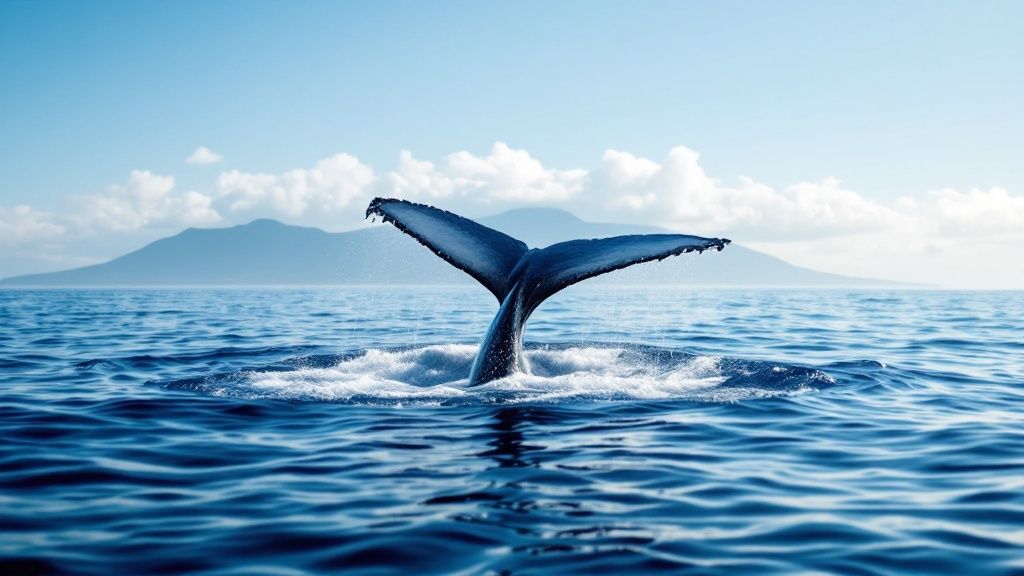
This guide will walk you through everything you need to plan the perfect trip. We'll dive into the incredible behaviors you might witness and break down how to choose the right tour for you and your family.
Choosing Your Guide Wisely
Let's be clear: picking an experienced crew is the single most important decision you'll make for a memorable and safe trip. As Hawaii's top-rated and most-reviewed snorkel and tour company, Kona Snorkel Trips really sets the bar for what an exceptional marine adventure should be. Their stellar reputation, backed by countless glowing reviews, is a testament to their passion for quality and happy customers.
An expert guide does so much more than just find whales. They’re storytellers, bringing context to the behaviors you’re seeing, explaining the migration patterns, and sharing their knowledge of the local marine ecosystem. Their insights turn a simple boat ride into a rich, immersive experience.
Choosing a tour operator with a deep respect for the ocean and its inhabitants ensures your adventure contributes positively to the preservation of these magnificent creatures for generations to come.
Knowing what to look for in a tour will help you make the most of your time on the water. In this guide, we'll cover:
- The incredible science behind the great migration to Hawaii.
- The best times of year—and even the best time of day—for sightings.
- The different tour styles available and what to expect from each.
- How to pack and prepare for a comfortable, amazing day on the ocean.
The Epic Journey of Hawaii's Humpback Whales
The story of the humpback whales you see on whale watching tours Kona Hawaii is one of nature’s most astounding tales of endurance. Every year, thousands of these massive animals undertake a grueling 3,000-mile swim from the krill-rich, icy waters of Alaska all the way to the warm, tropical embrace of Hawaii. It’s a journey driven by the most fundamental instinct of all: to create new life.
Hawaii’s waters don’t offer the whales food—in fact, they fast for their entire stay. Instead, these islands offer something far more precious. The calm, warm, and clear seas are the perfect sanctuary for pregnant females to give birth and for new mothers to nurse their calves away from harm. Kona's coastline, sheltered by the colossal volcanoes of Mauna Loa and Hualalai, creates an exceptionally protected bay that serves as a natural nursery.
This annual pilgrimage is a monumental effort. For months, the whales live entirely off the thick blubber reserves they built up during their summer feeding frenzy up north. Down here, their focus is singular: mating, birthing, and getting their newborns strong enough for the long journey back home.
Why Do They Make This Journey?
Simply put, it’s all about safety. The warm Hawaiian waters are a haven, relatively free from the predators—like pods of orcas—that pose a deadly threat to newborn calves in the colder Alaskan seas. This protected environment gives the young whales a critical head start, a safe space to grow and learn from their mothers without constant danger.
There's another crucial benefit: warmth. Newborn calves haven't yet developed the thick layer of insulating blubber that adults have. The balmy water temperature here means they don't have to burn precious energy just to stay warm, dedicating it all to rapid growth instead.
The annual whale migration cycle is the very reason we have a whale watching season in Kona. Their arrival kicks off a spectacular few months of surface activity, drawing people from all over the world to witness this incredible natural event.
This seasonal rhythm is remarkably predictable. We know the season has truly begun when local boat captains start radioing in the first sightings. That kicks off a period, typically running from December through May, when the waters off Kona are just teeming with life. To see when the first whales of the season often appear, check out this great resource on the timing of these first incredible sightings on Pacific Boat Sales.
Decoding Whale Behaviors
Knowing what you're looking at can turn a good whale watch into an unforgettable one. You’re not just seeing random splashes; you’re witnessing a complex language. Each behavior has a purpose.
- Breach: This is the showstopper. A 40-ton animal launching its entire body out of the water and crashing back down. Why? It could be a form of long-distance communication, a way to shake off skin parasites, or maybe—just maybe—it’s pure, unadulterated joy.
- Tail Slap (Lobtailing): A powerful, resounding smack of the tail on the water's surface. Think of it as a whale's way of making a point. It might be a warning to other whales to keep their distance or a sound meant to intimidate rivals.
- Pec Slap: You'll see the whale roll onto its side and repeatedly slap one of its long, 15-foot pectoral fins on the water. Like the tail slap, the loud crack it creates is another way they "talk" to each other across the waves.
- Spyhop: This one feels personal. A whale will slowly and deliberately lift its head straight out of the water, often looking right at the boat. It’s pure curiosity—they’re getting a better look at us, just as we are at them.
Finding the Perfect Time for Your Whale Tour
When it comes to whale watching in Kona, timing really is everything. While you can spot humpback whales here anytime from December through May, some months are simply on another level. Choosing the right time can be the difference between a distant glimpse and a front-row seat to one of nature's greatest shows.
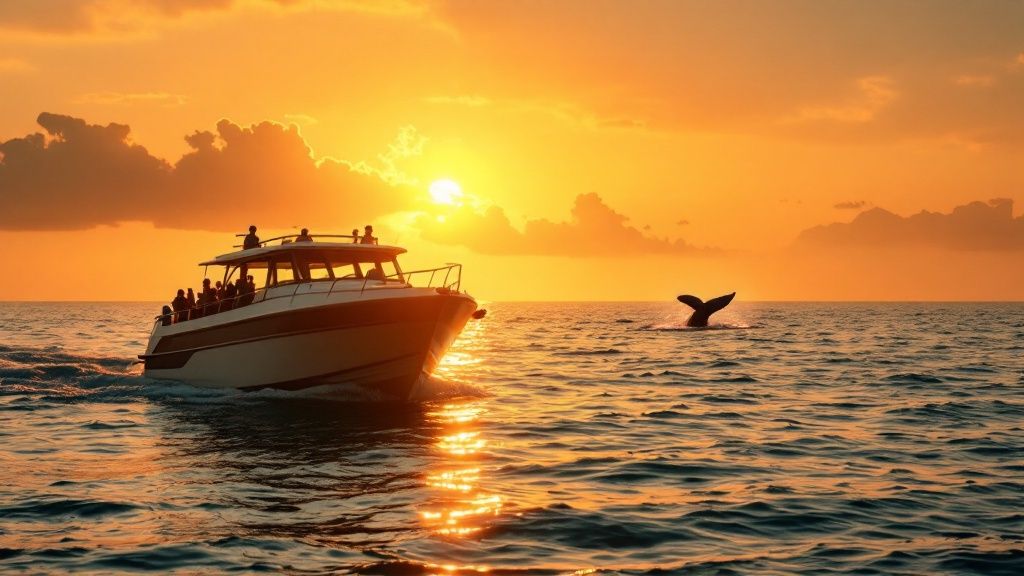
The real heart of the action happens in January and February. Think of it as peak rush hour on the "humpback highway." The sheer number of whales cruising the Kona coast is at its absolute highest during these months. This means you're far more likely to see the good stuff—males competing for a mate, a mother gently nudging her new calf, or the jaw-dropping spectacle of a full breach.
Here’s a simple breakdown to help you plan your trip.
Kona Whale Watching Season At a Glance
| Month | Whale Activity Level | What to Expect |
|---|---|---|
| December | Moderate | The first arrivals appear. Good chance of sightings, but activity is just ramping up. |
| January | High | Peak season begins! Lots of whales, including competition pods and early calves. |
| February | High | The absolute peak. The highest concentration of whales and a great time for surface activity. |
| March | Moderate | Still plenty of whales, with many mothers and calves preparing for the journey north. |
| April | Low | The last of the whales are heading out. Sightings are less frequent but still possible. |
| May | Very Low | The season is winding down. You might get lucky with a few stragglers. |
This table gives you a quick snapshot, but remember, these are wild animals on their own schedule!
The Best Time of Day for Seeing Whales
Once you've narrowed down the month, the next step is picking the right time of day. Most experienced captains and guides will tell you the same thing: go early. The morning is truly the golden hour for whale watching in Kona.
The ocean is usually at its calmest first thing in the morning, creating a glassy surface that makes it much easier to spot a distant spout or the dark arch of a whale's back. Plus, the whales themselves often seem a bit more energetic in the cooler morning air before the sun gets too high.
Don't just take our word for it. Over two decades of shore-based counts show that during the peak months of January and February, observers can spot 3 to 6 whales every 15 minutes.
This research also backs up the "early bird" strategy. Tours heading out around 8:00 am consistently report about 50% more sightings than those leaving in the afternoon. It’s a simple combination of calmer water and more active whales.
Booking an early tour gives you the best shot at seeing the full range of humpback behaviors against the stunning backdrop of a peaceful Pacific. It's a small planning detail that can lead to some seriously big memories.
Choosing the Right Kona Whale Watching Tour
With so many boats ready to take you out on the water, picking the perfect whale watching tour in Kona can feel like a big decision. But it doesn't have to be. The real secret is matching the tour style to your group's personality and what you hope to get out of the day.
Are you looking for a smooth, stable ride for the whole family? Or a thrilling, up-close adventure? Kona has an experience for everyone.
The kind of boat you’re on completely shapes your adventure. Large catamarans, for instance, are the hands-down favorite for families with young kids or anyone worried about getting seasick. Their dual-hull design cuts through the water, making for a super stable ride. Plus, they usually have creature comforts like onboard restrooms, shaded seating, and snacks.
On the flip side, smaller vessels like zodiacs or rafts offer a totally different vibe. These boats are low to the water, putting you practically at eye-level with the whales. It’s an incredibly intimate and exhilarating experience where you feel every wave and are right in the middle of the action.
Key Factors to Consider
Beyond just the boat, a few other details will help you nail down the perfect tour. Think about what's most important for your day at sea.
- Tour Duration: Trips can be as short as two hours or stretch into a half-day adventure. A shorter tour is great if you have a packed schedule, but a longer one gives you more time to find active whale pods and just sit back and watch their incredible behaviors unfold.
- Passenger Capacity: Do you enjoy the energy of a bigger boat with 50+ people, or would you prefer a more personal, small-group feel? Smaller groups often mean more one-on-one time with the captain and naturalist guides.
- Special Amenities: This is where tours really stand out. A key feature to look for is a hydrophone—an underwater microphone the crew can drop into the ocean. Hearing the haunting, complex songs of a male humpback whale in real-time is an experience you will never, ever forget.
Choosing a tour isn't just about the boat; it's about the entire experience. An experienced, eco-conscious operator with a passionate crew can transform a good trip into a truly unforgettable one.
If you're looking for more than just whales, some tours blend wildlife viewing with fascinating local history. You can find options like a combined wildlife watching and historical sightseeing tour that give you a much richer picture of Kona's incredible coastline.
Comparing Kona Whale Watching Tour Styles
To help you visualize the options, let's break down the most common tour types you'll find in Kona. This little cheat sheet should make your decision a whole lot easier.
| Tour Type | Best For | Pros | Cons |
|---|---|---|---|
| Large Catamaran | Families, large groups, and those prone to seasickness. | Very stable, lots of space, amenities like restrooms and shade. | Less intimate, larger crowds, sits higher off the water. |
| Zodiac-Style Raft | Adventurous travelers, photographers, and small groups. | Fast, exciting ride, close-to-the-water views, intimate experience. | Bumpy ride, minimal amenities, more exposure to sun and spray. |
| Sailboat | Couples and those seeking a peaceful, quiet experience. | Relaxing, eco-friendly (uses wind power), quiet for listening to whales. | Slower pace, dependent on wind, may cover less area. |
| Private Charter | Groups wanting a customized, exclusive experience. | Ultimate flexibility, privacy, personalized itinerary. | Most expensive option, requires advance booking. |
Ultimately, there is no single "best" boat—there's only the best boat for you. Thinking through these options will help ensure you have the amazing day on the water you've been dreaming of.
Practicing Responsible and Ethical Whale Watching
Getting to see humpback whales up close in their natural world is an incredible privilege. With that privilege comes a shared responsibility to make sure we're protecting them. The best whale watching tours Kona Hawaii has are built on a deep respect for these amazing animals and their ocean home, making your trip a force for good.
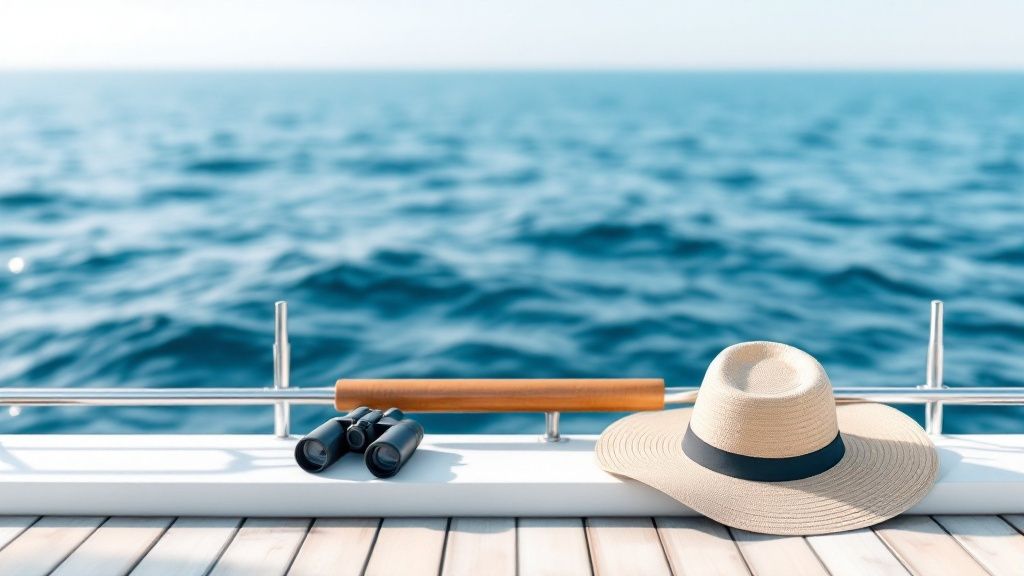
The image above comes straight from the Hawaiian Islands Humpback Whale National Marine Sanctuary, and it outlines the official guidelines everyone must follow. The most important rule—the one that’s the bedrock of ethical whale watching in Hawaii—is all about keeping a safe distance.
Maintaining a Safe Distance
To avoid stressing the whales or interrupting their natural behaviors like nursing, resting, or mating, all boats must stay at least 100 yards away. To put that in perspective, think of the length of a football field.
Any reputable tour company takes this federal law very seriously. Their captains are experts at maneuvering the boat to give you a fantastic view without ever getting too close or crowding the animals.
Now, this rule is about how close the boat can get to the whale. Whales, being curious creatures, don't always follow the rules. Sometimes, they decide to approach the boat on their own. When this happens, it’s an unforgettable moment called a "mugging," and the captain will simply put the engines in neutral and let the whales take the lead.
Contributing to Conservation Efforts
When you pick a responsible tour operator, you're directly supporting the health of Hawaii's entire marine ecosystem. These companies don't just follow the rules—they often go above and beyond, actively participating in conservation work.
- Education: A great tour isn't just about seeing whales; it's about understanding them. The best guides are passionate naturalists who share fascinating insights into whale biology, behavior, and the threats they face, turning your tour into a powerful learning experience.
- Research Partnerships: Many local operators work hand-in-hand with research organizations. They contribute sighting data, report any whales that appear entangled, and even provide a platform for scientists to conduct studies out on the water.
- Citizen Science: You might be surprised how much community involvement helps protect these whales. For years, dedicated volunteers have run coordinated counts across the islands. In one recent season, they counted 714 humpbacks, with 28 spotted from Big Island sites alone! It's one of the longest-running citizen science projects for whale monitoring in the world. You can read more about these impressive whale count results on Big Island Video News.
By keeping these principles in mind and choosing your tour wisely, your adventure becomes more than just a spectacular day on the ocean. It becomes a meaningful way to help preserve Hawaii's beloved humpback whales for generations to come.
Preparing for Your Day on the Ocean
A little bit of prep work can make all the difference between a good day on the water and an absolutely unforgettable one. When you're comfortable and have the right gear, you can stop worrying about the small stuff and focus on the incredible show the whales are putting on.
The weather out on the ocean can be a totally different story than what you feel on shore. Mornings often start out cool, especially with the breeze coming off the water, but that sun can get surprisingly intense by midday. Dressing in layers is the secret to a comfortable trip. Think a light, wind-resistant jacket over a t-shirt—you can easily shed a layer as the day heats up.
Your Essential Packing Checklist
Packing smart means you're ready for whatever the ocean has in store. Your tour operator will have all the safety essentials covered, but bringing a few personal items will make your adventure that much better.
- Reef-Safe Sunscreen: The Hawaiian sun is no joke, even when it's cloudy. Do your skin and our delicate coral reefs a favor by choosing a mineral-based sunscreen. Look for ingredients like zinc oxide or titanium dioxide.
- Polarized Sunglasses: Honestly, these are a non-negotiable. They cut the glare on the water's surface, making it so much easier to spot a spout or a fluke. It's a total game-changer.
- A Hat and Light Cover-Up: A wide-brimmed hat is your best friend for protecting your face and neck. It’s also a good idea to bring a light long-sleeved shirt or a sarong for extra coverage if you're sensitive to the sun.
- Camera with a Zoom Lens: Your phone camera will do in a pinch, but a real camera with a good zoom lens will help you capture those mind-blowing breaches and tail slaps. Federal law requires boats to stay 100 yards away, so that zoom comes in handy!
- Reusable Water Bottle: Staying hydrated out there is key. Most tours provide water, but bringing your own bottle is a great way to help us keep our oceans clean.
Staying Comfortable at Sea
For some of us, the gentle sway of the boat is more of a worry than a comfort. The absolute last thing you want is for seasickness to get in the way of watching a 40-ton humpback launch itself out of the water.
Motion sickness is way easier to prevent than it is to treat. A few simple steps before you even leave the dock can ensure you and your family have an amazing time.
There are plenty of simple, effective tricks to keep that queasy feeling away, from over-the-counter medications to natural remedies like ginger. For a complete rundown, you can learn more about how to prevent seasickness on our blog. With these tips, you'll be all set for an incredible day.
Your Kona Whale Watching Questions Answered
Getting ready for a whale watching trip always brings up a few questions. To make sure you feel confident and excited for your day on the water, we’ve put together answers to some of the things people ask us most.
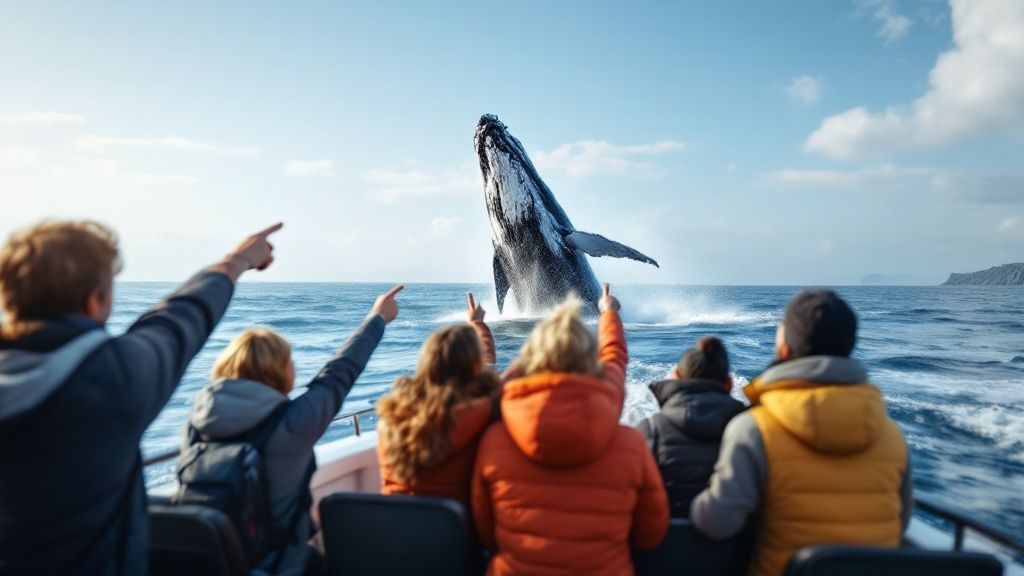
So, Are We Guaranteed to See Whales?
This is the big one! While Kona is one of the best places on Earth to see humpbacks during the season (especially January through March), remember these are wild animals. As such, no tour can ever promise a 100% guaranteed sighting.
That said, experienced crews know exactly where to look and have an incredibly high success rate. Many will even offer a "whale guarantee," which means if you don't spot any whales, you can come back for another trip free of charge, as long as there's space.
How Close Can the Boat Get to the Whales?
Federal law is very strict about protecting these gentle giants. All vessels are required to stay at least 100 yards away from humpback whales. To give you a better idea, picture a football field—that’s the minimum distance we must keep to avoid disturbing them.
Of course, whales are curious and don't know the rules. Sometimes, one might decide to swim right up to the boat to check things out! When this happens, it’s called a "mugging," and it is an absolutely unforgettable, once-in-a-lifetime experience.
What Else Might We Spot Out There?
While the humpbacks are the stars of the show, the ocean off Kona is full of life. It’s very common to be greeted by playful spinner dolphins putting on an acrobatic show or to see pods of bottlenose dolphins riding the wake of the boat.
Keep an eye out for Hawaiian green sea turtles, or honu, popping their heads up for a breath of air. On a really lucky day, you might even catch a glimpse of more elusive creatures like pilot whales or the massive, majestic whale shark.
Is This Trip a Good Idea for Young Kids?
Definitely! Whale watching is an amazing way to connect kids with nature and create lasting family memories. For families, we usually recommend choosing a larger, more stable boat like a catamaran. They offer a smoother ride and often have kid-friendly amenities like restrooms and plenty of shade.
It’s a fantastic adventure that can spark a real passion for marine life in your little ones.
Ready to see Hawaii's magnificent humpback whales for yourself? For a world-class adventure led by a passionate crew, join us at Kona Snorkel Trips.
Take a look at our whale watching tours and other ocean adventures and book your trip today
